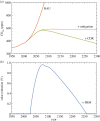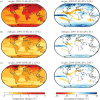Solar geoengineering as part of an overall strategy for meeting the 1.5°C Paris target
- PMID: 29610384
- PMCID: PMC5897825
- DOI: 10.1098/rsta.2016.0454
Solar geoengineering as part of an overall strategy for meeting the 1.5°C Paris target
Abstract
Solar geoengineering refers to deliberately reducing net radiative forcing by reflecting some sunlight back to space, in order to reduce anthropogenic climate changes; a possible such approach would be adding aerosols to the stratosphere. If future mitigation proves insufficient to limit the rise in global mean temperature to less than 1.5°C above preindustrial, it is plausible that some additional and limited deployment of solar geoengineering could reduce climate damages. That is, these approaches could eventually be considered as part of an overall strategy to manage the risks of climate change, combining emissions reduction, net-negative emissions technologies and solar geoengineering to meet climate goals. We first provide a physical-science review of current research, research trends and some of the key gaps in knowledge that would need to be addressed to support informed decisions. Next, since few climate model simulations have considered these limited-deployment scenarios, we synthesize prior results to assess the projected response if solar geoengineering were used to limit global mean temperature to 1.5°C above preindustrial in an overshoot scenario that would otherwise peak near 3°C. While there are some important differences, the resulting climate is closer in many respects to a climate where the 1.5°C target is achieved through mitigation alone than either is to the 3°C climate with no geoengineering. This holds for both regional temperature and precipitation changes; indeed, there are no regions where a majority of models project that this moderate level of geoengineering would produce a statistically significant shift in precipitation further away from preindustrial levels.This article is part of the theme issue 'The Paris Agreement: understanding the physical and social challenges for a warming world of 1.5°C above pre-industrial levels'.
Keywords: 1.5; climate change; geoengineering.
© 2018 The Author(s).
Conflict of interest statement
We declare we have no competing interests.
Figures






Similar articles
-
Solar geoengineering to reduce climate change: a review of governance proposals.Proc Math Phys Eng Sci. 2019 Sep;475(2229):20190255. doi: 10.1098/rspa.2019.0255. Epub 2019 Sep 4. Proc Math Phys Eng Sci. 2019. PMID: 31611719 Free PMC article. Review.
-
Towards legitimacy of the solar geoengineering research enterprise.Philos Trans A Math Phys Eng Sci. 2018 May 13;376(2119):20160459. doi: 10.1098/rsta.2016.0459. Philos Trans A Math Phys Eng Sci. 2018. PMID: 29610369 Free PMC article. Review.
-
Transient climate-carbon simulations of planetary geoengineering.Proc Natl Acad Sci U S A. 2007 Jun 12;104(24):9949-54. doi: 10.1073/pnas.0700419104. Epub 2007 Jun 4. Proc Natl Acad Sci U S A. 2007. PMID: 17548822 Free PMC article.
-
Geoengineering the climate: an overview and update.Philos Trans A Math Phys Eng Sci. 2012 Sep 13;370(1974):4166-75. doi: 10.1098/rsta.2012.0186. Philos Trans A Math Phys Eng Sci. 2012. PMID: 22869795
-
Solar geoengineering to limit the rate of temperature change.Philos Trans A Math Phys Eng Sci. 2014 Dec 28;372(2031):20140134. doi: 10.1098/rsta.2014.0134. Philos Trans A Math Phys Eng Sci. 2014. PMID: 25404687
Cited by
-
Anticipatory governance of solar geoengineering: conflicting visions of the future and their links to governance proposals.Curr Opin Environ Sustain. 2020 Aug;45:10-19. doi: 10.1016/j.cosust.2020.06.004. Epub 2020 Aug 13. Curr Opin Environ Sustain. 2020. PMID: 32843906 Free PMC article. Review.
-
Injecting solid particles into the stratosphere could mitigate global warming but currently entails great uncertainties.Commun Earth Environ. 2025;6(1):132. doi: 10.1038/s43247-025-02038-1. Epub 2025 Feb 21. Commun Earth Environ. 2025. PMID: 39990961 Free PMC article.
-
Solar geoengineering can alleviate climate change pressures on crop yields.Nat Food. 2021 May;2(5):373-381. doi: 10.1038/s43016-021-00278-w. Epub 2021 May 20. Nat Food. 2021. PMID: 37117731
-
Solar geoengineering to reduce climate change: a review of governance proposals.Proc Math Phys Eng Sci. 2019 Sep;475(2229):20190255. doi: 10.1098/rspa.2019.0255. Epub 2019 Sep 4. Proc Math Phys Eng Sci. 2019. PMID: 31611719 Free PMC article. Review.
-
Stratospheric aerosol injection can weaken the carbon dioxide greenhouse effect.Commun Earth Environ. 2025;6(1):485. doi: 10.1038/s43247-025-02466-z. Epub 2025 Jun 20. Commun Earth Environ. 2025. PMID: 40546271 Free PMC article.
References
-
- UNFCCC. 2015. Adoption of the Paris Agreement. See https://unfccc.int/resource/docs/2015/cop21/eng/l09.pdf.
-
- Rogelj J, Luderer G, Pietzcker RC, Kriegler E, Schaeffer M, Krey V, Riahi K. 2015. Energy system transformations for limiting end-of-century warming to below 1.5°C. Nat. Clim. Change 5, 519–527. (10.1038/nclimate2572) - DOI
-
- Sanderson B, O’Neill B, Tebaldi C. 2016. What would it take to achieve the Paris temperature targets? Geophys. Res. Lett. 43, 7133–7142. (10.1002/2016GL069563) - DOI
-
- National Academy of Sciences. 2015. Climate intervention: carbon dioxide removal and reliable sequestration. Washington DC: The National Academies Press.
LinkOut - more resources
Full Text Sources
Other Literature Sources

